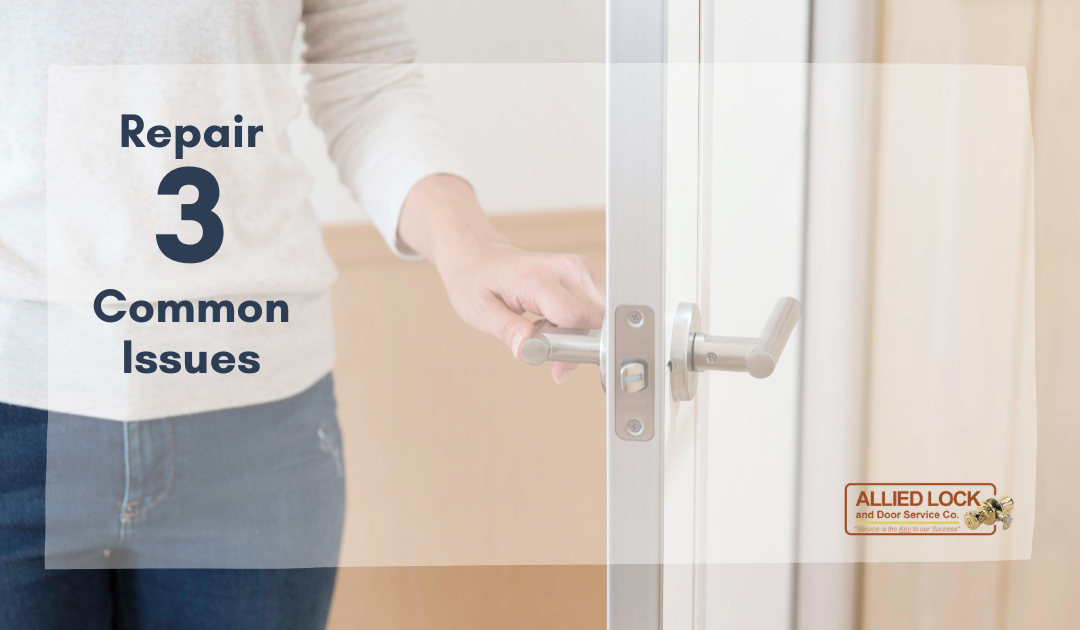When it comes to your home’s security, the proper functioning of your door locks and knobs is critical. Whether you’re dealing with a front door lock sticking, trying to understand how doorknobs work, or grappling with how to fix a door lock, it’s important to know what to do when your home’s access points are compromised. Let’s delve deeper into how to manage such situations, including those involving a key lock door knob and a stuck deadbolt lock.
How to Repair Common Door Knob and Lock Problems
You may find yourself dealing with different types of locks around your home, from the front door to internal areas like bedrooms and bathrooms. For example, you may have bedroom door knobs without locks for privacy and ease of use, or you might encounter a bathroom door with a small hole and a push button for a simple lock mechanism. Regardless of the type, it’s useful to know how to troubleshoot common issues.
Dealing with a Jammed Door Knob
When you encounter a door knob jammed, it can be a frustrating experience. This often happens due to dirt or misalignment in the mechanism. A common solution is to use a small flat head screwdriver to gently adjust the components inside the knob. Insert the screwdriver into the slot on the knob and carefully wiggle it to realign the internal parts. This method is particularly useful for a locked bathroom door or any internal door that doesn’t open smoothly.
Fixing a Door Knob Locked from Inside
Sometimes, you may find your door knob locked from inside, making it challenging to gain access. In such cases, a bobby pin or a small flathead screwdriver can come in handy. Straighten the bobby pin and insert it into the hole in the center of the doorknob. Apply gentle pressure while turning the knob to unlock it. This technique is especially useful for bathroom and bedroom doors that might accidentally lock themselves.
Stuck Lock Button on Doorknobs
Typically found on bathroom doors, lock buttons can sometimes get stuck. This issue is usually due to misaligned parts within the locking system, but thankfully, it’s relatively easy to solve. Try pushing and holding the lock button firmly, then quickly release it to unjam it. If this doesn’t work, try depressing the lock button consecutively or jiggling the handle vigorously.
Addressing a Door Knob That Opens When Locked
A door knob that opens when locked indicates a faulty latch or misaligned strike plate. To address this, first examine the alignment of the door with the frame. You might need a flat head screwdriver to adjust the strike plate so that the latch catches properly. Ensuring proper alignment and function is crucial for maintaining the security of your home.
Solutions for a Door Knob That Won’t Lock
If you find that your door knob won’t lock, it could be due to a variety of reasons. Common issues include a misaligned latch or a problem with the locking mechanism itself. Using a small flat head screwdriver, you can attempt to realign the latch with the strike plate on the door frame. If the problem persists, it might indicate a need for a more thorough repair or replacement of the lock mechanism.”
Front Door Lock Sticking and Key Lock Door Knob Issues
If your front door lock is sticking, or if the key lock door knob isn’t working, it could be due to a range of issues. Damages from freezing, rust, or wear and tear can all affect the latch bolt’s function. In some cases, replacing internal components can solve the problem, but in severe cases, you may need to replace the entire unit.
Troubles with Stuck Deadbolt Locks
A stuck deadbolt lock is a common issue that can compromise your home’s security. The lock’s internal mechanism may have rust or freezing that keeps it in a resting position. To troubleshoot, check if your key is damaged, or use a thumb turn to force the bolt to rotate. If the door itself is causing the lock issues, inspect your door frame and flooring for damages or unevenness.
How to Fix Door Lock Inside
When dealing with how to fix door lock inside, especially if you have a locked door that won’t open, you might need to dismantle the lock. Carefully use a flat head screwdriver to remove the screws from the door knob and inspect the internal mechanism. Cleaning and lubricating the parts often resolves the issue. If the lock is damaged, however, replacement might be necessary.
Conclusion
Just like other household fixtures and appliances, your locks and doorknobs can suffer from wear and tear. So, whether it’s your front door or your bathroom, it’s crucial to take good care of them and have a reliable locksmith conduct major repairs and maintenance when necessary.
At Allied Lock and Door, we offer door lock repair services in Cincinnati, Ohio for homeowners dealing with lock and key mechanism issues. If you need repairs, replacements, or regular maintenance, get in touch with us today! We’re here to help with everything from a front door lock sticking to a stuck deadbolt lock, and everything in between.

